


TELOS 6 180W LED
The Telos series is a range of full spectrum LED systems designed and manufactured in the UK by GN for growing taller plants in both harsh greenhouse conditions and indoor farming platforms where natural light may be limited. The Telos 6 has 6 30W modules, drawing 180W and providing a PPF output of 336.78μmol/s.
Featuring a waterproof and dustproof design, the Telos 6 can withstand any growing environment while providing a natural light for working under. The use of passive natural convection has eliminated the need for a fan, reducing noise output and significantly increasing the life span of the light as it contains no moving parts.

TELOS 8 240W LED
The Telos series is a range of full spectrum LED grow lights designed and manufactured in the UK by GN for growing taller plants in both harsh greenhouse conditions and indoor horticulture platforms. The Telos 8 has 8 30W modules, drawing 240W and providing a PPF output of 449.8μmol/s.
Featuring a waterproof and dustproof design, the Telos 8 can withstand any growing environment while providing a natural light for working under. The use of passive natural convection has eliminated the need for a fan, reducing noise output and significantly increasing the life span of the light as it contains no moving parts.

TELOS 10 300W LED
The Telos series is a range of full spectrum LED grow lights designed and manufactured in the UK by GN for growing taller plants in both harsh greenhouse conditions and indoor horticulture platforms. The Telos 10 has 10 30W modules, drawing 300W and providing a PPF output of 558.9μmol/s.
Featuring a waterproof and dustproof design, the Telos 10 can withstand any growing environment while providing a natural light for working under. The use of passive natural convection has eliminated the need for a fan, reducing noise output and significanlty increasing the life span of the light as it contains no moving parts.

Our enhanced full spectrum LED grow lights use a blend of white and photo-red LEDs to provide a highly efficient solution for horticultural applications.The light intensity distribution of the Telos range has been calibrated to provide optimal light absorption through a stable, homogenised source, reducing 'hot spots' which can occur in other lighting products. Previous generations of LED grow lights used a mixture of royal blue and photo-red LED's to target chlorophyll absorption peaks. Whilst these solutions worked adequately they missed out important spectra for quality plant growth, lacked penetration through dense canopies and provided poor visibility for inspecting and maintaining growth chambers.
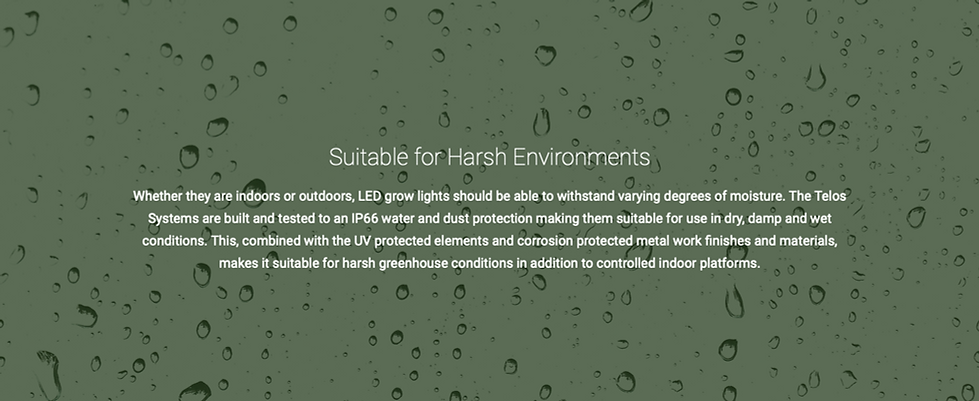

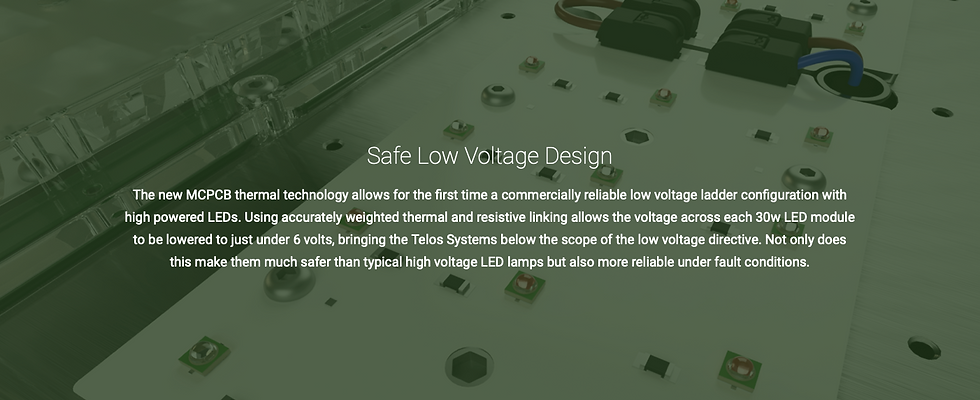

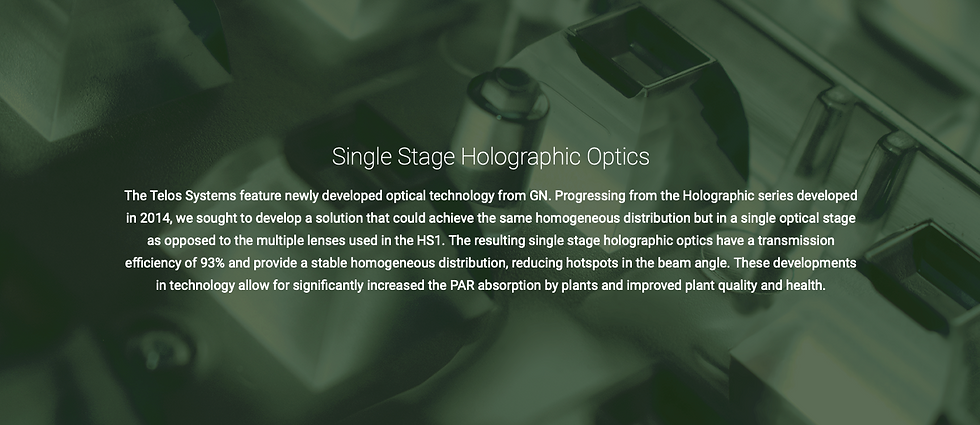

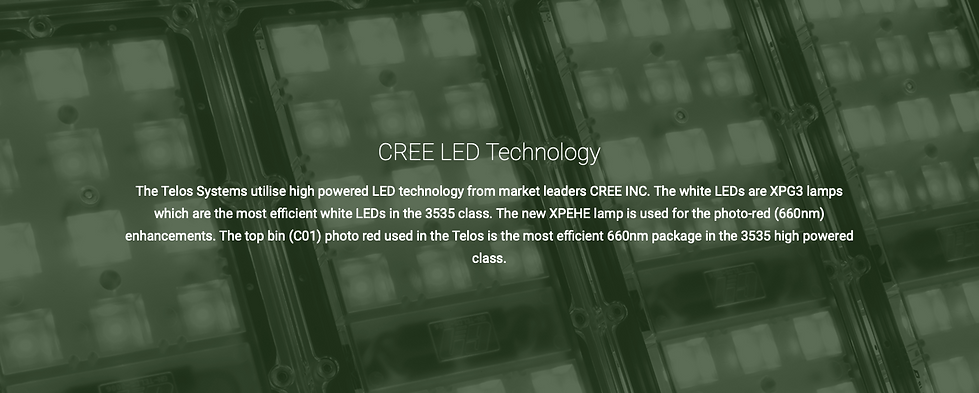
Photosynthesis and Green Light
Many companies focus their spectrum on delivering the optimal light for photosynthesis. Traditionally this meant using light soley from the blue and red part of the spectrum as studies showed that these are the wavelengths most absorbed by chlorophyll A and B and therefore are drivers of photosynthesis. But chlorophyll A and B absorbtion is not the only factor in photosynthesis
Green Light and the McCree Curve
You may hear it a lot that green light is reflected by plants, giving them their green colour, therefore plants do not use green light and it is wasteful to include green light in your spectrum. This is not the case.
A paper published in the 70s by K. J. McCree shows us that green light is not only used by plants for photosynthesis but it is almost as effective as blue light in some plant species. The McCree Curve shows the relative effectiveness of individual wavelengths on photosynthesis. It is thought that this use of green light is down to pigments such as carotenoids that absorb green light and transfer the engery to chlorophyll for photosynthesis.
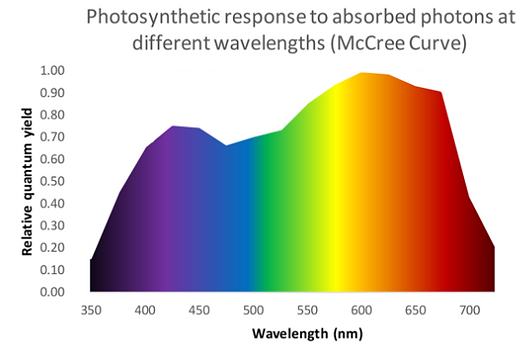
Use of McCree Curve Criticisms
Many lighting companies misuse the McCree curve viewing it as a blueprint for ideal spectral power distribution. This is not correct for a few reasons. The McCree curve was produced from experiments using individual wavelengths of light to measure photosynthetic response and doesn't indicate the response to a full spectrum of light. Also, these experiments were conducted using small leaf samples of 22 food crop plant species and therefore do not reflect the response of a whole plant or of all plant species. Finally the curve represents photons that have been absorbed, not photons emitted from a light source.
Other Benefits of Green Light
While little is known about the potential role green light plays in photomorphogenesis there are other benefits to having green light in your spectrum. Studies show that green light is efficient at penetrating through canopies, increasing photosynthesis beneath the canopy and increasing yields. Adding green light to grow light spectra will also increase the colour rendering index of the light, providing a more natural white light which will make it easier to inspect crops.
Photomorphogenesis
Photomorphogenesis is plant development that is triggered by light, such as seed germination, seedling development and flowering in photoperiod crops. This development is triggered photoreceptors in the plant that respond to absorbing certain wavelengths of light. Typically plants contain phytochromes, which are photoreceptors that respond to red and far red light, and crypto-chromes that respond to blue light.
Red Light and Far Red Light
Red and far red light trigger many developmental processes in plants. Phytochromes are responsible for processes such as flowering in short and long day plants, stem elongation in response to shade and the production of flavinoids such as anthocyanin (blue-purple plant pigment). There are two forms of phytochromes; red light absorbing, Pr and far red light absorbing, Pfr. Pr converts into Pfr after absorbing red light and Pfr converts into Pr after absorbing far red light. Red light is generally available to plants during the daytime, and far red light available in the shade and during the night, therefore plants use Pfr and Pr levels to determine when there are changes in the length of daylight and when they are in the shade.
Blue Light
Blue light is responsible for similar processes to red and far red light. One of the differences is that cryptochromes (which absorb blue light) can inhibit stem elongation. This means that adding more blue light to a spectrum could be ideal for those looking to offset the stretch that can be caused by far red light (shade response). This often occurs in greenhouses where there is an abundance of far red light. Blue light is also the trigger for phototropism where plants move and grow towards the light.
